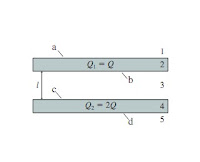 |
| Figure 1 |
PART A:
Determine the electric field strength E1 in region 1. Give your answer as a multiple of Q/ε0.
Express your answer in terms of some or all of the variables l, A, Q, and the constant π.
SOLUTION:
One Gaussian surface is a cylinder with end-area a extending past the two metal slabs. A second Gaussian surface ends in region 3, the space between the slabs
Using Gauss's Law, ∫E⋅dA = ∫top E⋅dA + ∫bottom E⋅dA + ∫sides E⋅dA = E1a + E5a + 0 = Qin / ε0
The total charge per unit area on both surfaces of the top slab is Q1/A = Q/A, so the charge enclosed within the cylinder is Qa/A.
Similarly, the enclosed charge on the lower slab is Q2a/A = 2Qa/A
Thus, E1a + E5a = Qa/(A⋅ε0) + 2Qa/(A⋅ε0) = 3Qa/(A⋅ε0)
∴ E1 + E5 = 3Q/(A⋅ε0)
∴ E1 + E5 = 3Q/(A⋅ε0)
Fields E1 & E5 are both a superposition of the fields of four sheets of surface charge. Because the field of a plane of charge is independent of distance from the plane, the superposition at points above the top plane must be the same magnitude, but opposite direction, as the superposition at points below the bottom plane.
∴ E1 = E5 = 1/2(3Q/(A⋅ε0))
E1 = 3/2A ⋅Q/ε0
-----------------------------------------------------------------------------------------------------
PART B:
Determine the electric field strength E2 in region 2. Give your answer as a multiple of Q/ε0.
Express your answer in terms of some or all of the variables l, A, Q, and the constant π.
SOLUTION:
Because these are metals we immediately know that E2 = E4 = 0
0
-----------------------------------------------------------------------------------------------------
PART C:
Determine the electric field strength E3 in region 3. Give your answer as a multiple of Q/ε0.
Express your answer in terms of some or all of the variables l, A, Q, and the constant π.
Express your answer in terms of some or all of the variables l, A, Q, and the constant π.
SOLUTION:
Consider the Gaussian surface on the right. The lower slab is more positive than the upper slab, so the electric field in region 3 must point upward, into the lower face of this cylinder.
∫E⋅dA = ∫top E⋅dA + ∫bottom E⋅dA + ∫sides E⋅dA = E1a - E3a + 0 = Qin / ε0
∫E⋅dA = ∫top E⋅dA + ∫bottom E⋅dA + ∫sides E⋅dA = E1a - E3a + 0 = Qin / ε0
where the minus sign with E3 is because of the direction. We know E1, and we've already determined Qin = Qa/A.
Thus, E3 = E1 - Q/(A⋅ε0) = 3Q/(2A⋅ε0) - Q/(A⋅ε0)
∴ E3 = Q/(2A⋅ε0)
E3 = 1/2A ⋅Q/ε0
-----------------------------------------------------------------------------------------------------
PART D:
Determine the electric field strength E4 in region 4. Give your answer as a multiple of Q/ε0.
Express your answer in terms of some or all of the variables l, A, Q, and the constant π.
SOLUTION:
See part B
0
-----------------------------------------------------------------------------------------------------
PART E:
Determine the electric field strength E5 in region 5. Give your answer as a multiple of Q/ε0.
Express your answer in terms of some or all of the variables l, A, Q, and the constant π.
SOLUTION:
See Part A
E5 = 3/2A ⋅Q/ε0
-----------------------------------------------------------------------------------------------------
PART F:
Determine the surface charge density ηa on the surface a. Give your answer as a multiple of Q/A.
SOLUTION:
The electric field at the surface of a conductor is E = η/ε0
We can use the known fields and η = ε0E to find the four surface charge densities.
At surface a, E1 points away from the surface, Thus
ηa = ε0E1 = ε0⋅3Q/(2A⋅ε0) = 3Q/(2A)
ηa = 3/2⋅Q/A
-----------------------------------------------------------------------------------------------------
PART G:
Determine the surface charge density ηb on the surface b. Give your answer as a multiple of Q/A.
SOLUTION:
At surface b, E3 points toward the surface, Thus
ηb = -ε0E1 = -ε0⋅Q/(2A⋅ε0) = -Q/(2A)
ηb = -1/2⋅Q/A
-----------------------------------------------------------------------------------------------------
PART H:
Determine the surface charge density ηc on the surface c. Give your answer as a multiple of Q/A.
SOLUTION:
Surface c is opposite to surface b, because the field points away from the surface.
Therefore, ηc = - ηb = Q/(2A)
Therefore, ηc = - ηb = Q/(2A)
ηc = 1/2⋅Q/A
-----------------------------------------------------------------------------------------------------
PART I:
Determine the surface charge density ηd on the surface d. Give your answer as a multiple of Q/A.
SOLUTION:
At surface d, the field points away from the surface and has the same strength as E1
Therefore, ηd = ηa = 3Q/(2A)
ηd = 3/2⋅Q/A
Therefore, ηd = ηa = 3Q/(2A)
ηd = 3/2⋅Q/A
-----------------------------------------------------------------------------------------------------
Thank you!!!!
ReplyDeleteThis was incredibly helpful!
ReplyDelete